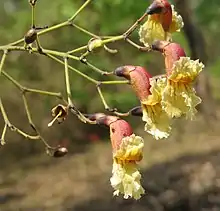| Yellow snake tree | |
|---|---|
 | |
| Scientific classification | |
| Kingdom: | Plantae |
| Clade: | Tracheophytes |
| Clade: | Angiosperms |
| Clade: | Eudicots |
| Clade: | Asterids |
| Order: | Lamiales |
| Family: | Bignoniaceae |
| Genus: | Stereospermum |
| Species: | S. tetragonum |
| Binomial name | |
| Stereospermum tetragonum | |
| Synonyms[1] | |
| |
Stereospermum tetragonum, the yellow snake tree, is 15–20 m tall, trunk 15–25 cm in diam, large leaves 25–50 cm; leaflets 3–6 on each side of midrib, long elliptic, 8-14 X 2.5–6 cm. Large, pale yellow, trumpet shaped flowers occur in panicles. Flowers are pale yellow, slightly curved, about 2 cm, upper lip 2-lobed, lower lip 3-lobed, tomentose at mouth, tube terete. The fruit is long, 4-angular, slightly curved, 30–70 cm, about 1 cm in diameter. This, probably, is the source of its common name, snake tree.
Also known as Stereospermum colais,[2] it is found in India, Myanmar and Sri Lanka: where it is "common in moist deciduous forests and occasional in openings or margins of evergreen forests, up to 1200 m."[3]
In Vietnam, Stereospermum colais is known as quao núi. Its young leaves can be eaten as a vegetable in Vietnam's Central Highlands.
References
- ↑ The Plant List: A Working List of All Plant Species, retrieved 18 September 2016
- ↑ The Plant List
- ↑ India Biodiversity Portal